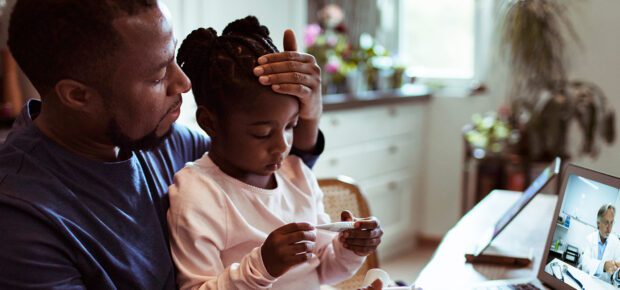July 28, 2021
The COVID-19 pandemic accelerated the adoption of telehealth capabilities across the globe. In the U.S., according to the CDC, about 43% of surveyed health centers were capable of providing telehealth services in April 2019. One year later, that number stood at 95%. Other parts of the world also saw an increased demand for telehealth services.
But reviews of telehealth maturity regional differences show variations between urban and rural areas and between rich and poor countries. In the U.S. at least, there were even seasonal fluctuations as the perceived severity of COVID-19 changed over the course of 2020.
Telehealth is convenient. And it holds the promise of expanding access to the underserved. But in its current nascent stage, there are technological opportunities that must be pursued to help foster broad-based adoption.
So what will it take for telehealth to become the “new normal,” and fulfill its promise of easy, expanded access to health services?
That’s a question that IEEE Senior Members Narendra Mangra and Bruce Hecht want to answer. Mangra and Hecht are co-chairs of the IEEE Standard Association’s “Transforming the Telehealth Paradigm: Sustainable Connectivity, Accessibility, Privacy, and Security for All Industry Connections” program.
The IEEE Standards Association is working on a group of interrelated challenges: addressing inconsistent or absent technical and security protocols, establishing frameworks for security, connectivity, accessibility and privacy for future innovation and creating a reliable resource for healthcare practitioners and facilities to best evaluate solutions and guidance for utilizing a trusted telehealth platform for patient care delivery.
Simultaneously, David Witkowski, IEEE Senior Member and co-chair of the Deployment Working Group at IEEE Future Networks, is working on optimizing the deployment of 4G/5G network solutions that will help to tackle the challenges inhibiting quality and sustainable access to immediate and critical care for unconnected and underserved patients.
Bringing Stakeholders Together
“Telehealth services promise to extend their reach toward unserved and underserved communities, and increase the depth and diversity of healthcare services,” Mangra says. “This also creates a renewed interest and opportunity for diverse groups to revisit the challenge for healthcare inequity and the necessary underlying support for broadband capabilities.”
Those diverse groups include local governments that have rules about the size, shape and weight of equipment that can be attached to light poles. Witkowski says that his working group helps technologists “understand what local governments expect. In turn, they help us by letting us know the state of the art and what form factors the equipment might ultimately take.”
For health care providers, security is something that is top-of-mind.
“Recent ransomware attacks and security breaches have placed trust at the forefront of several industries, including health care,” Mangra said. “It may be necessary to engage with policy makers, as health care providers may not have the necessary resources and expertise to address security vulnerabilities and events.”
And then there is the challenge of bringing telehealth to the underserved.
“There’s no magic technology that will make connecting the unconnected (or underconnected) possible — the solutions are based in economics and political will,” Witkowski said. “Governments are not typically equipped or qualified to deploy broadband networks, so we must rely on private industry to build these networks ––and incentivize them if they don’t. The economics have to work.”
For remote, rural, and underserved areas, broadband access could bring usher in the availability of medical treatment. Groups like IEEE SA Rural Communications Industry Connections Program and IEEE’s Connecting the Unconnected initiative are working to establish frameworks for improved telecommunications access, including frugal 5G technologies, microgrids to provide consistent electrical access and macrocells to provide carpet coverage.
How Standards Improve Telehealth
From Hecht’s perspective, consistent standards will allow telehealth to address the entire continuum of care, from birth to end-of-life, with access in rural and urban environments.
“A coordinated telehealth approach promises to deliver better and more customized health care services, including preventative care, better quality of care, improved provider and patient interactions and cost savings,” Hecht said. “New innovations and health care models will also emerge as telehealth services and standards proliferate.”
How Better Networks Improve Adoption
Witkowski says that broadband quality and availability have an impact on the wide adoption of telehealth.
He noted that users can’t pick up on non-verbal clues that play an often-underappreciated role in human communications, like body language or facial expressions. The constant need to ask for clarification and for speakers to repeat themselves is surprisingly taxing. The result is that users –– both practitioners and patients–– incur a higher “cognitive load” during video calls, resulting in “Zoom fatigue.”
Often, this stems from poor broadband connections. The rollout of 5G networks is expected to have a big impact on improving them.
“The key to successful medical care is a combination of medical knowledge and compassionate human interaction,” Witkowski said. “Cognitive load does not support the compassionate human interaction medical practitioners need to help us get and stay well. We can reduce cognitive load through better networks, and by making the interaction feel more instantaneous and natural. 5G has the potential to deliver this near-real time interaction.”
During the pandemic, people turned to telehealth services for emotional support and mental health treatment. Did psychotherapists think it was effective? This article explores that question.






 Liquid Infrastructure: Our Planet's Most Precious Resource
Liquid Infrastructure: Our Planet's Most Precious Resource The Impact of Technology in 2025
The Impact of Technology in 2025 Quantum and AI: Safeguards or Threats to Cybersecurity?
Quantum and AI: Safeguards or Threats to Cybersecurity? Why AI Can't Live Without Us
Why AI Can't Live Without Us Bits, Bytes, Buildings and Bridges: Digital-Driven Infrastructure
Bits, Bytes, Buildings and Bridges: Digital-Driven Infrastructure Impact of Technology in 2024
Impact of Technology in 2024 Emerging AI Cybersecurity Challenges and Solutions
Emerging AI Cybersecurity Challenges and Solutions The Skies are Unlimited
The Skies are Unlimited Smart Cities 2030: How Tech is Reshaping Urbanscapes
Smart Cities 2030: How Tech is Reshaping Urbanscapes Impact of Technology 2023
Impact of Technology 2023 Cybersecurity for Life-Changing Innovations
Cybersecurity for Life-Changing Innovations Smarter Wearables Healthier Life
Smarter Wearables Healthier Life Infrastructure In Motion
Infrastructure In Motion The Impact of Tech in 2022 and Beyond
The Impact of Tech in 2022 and Beyond Cybersecurity, Technology and Protecting Our World
Cybersecurity, Technology and Protecting Our World How Technology Helps us Understand Our Health and Wellness
How Technology Helps us Understand Our Health and Wellness The Resilience of Humanity
The Resilience of Humanity Harnessing and Sustaining our Natural Resources
Harnessing and Sustaining our Natural Resources Creating Healthy Spaces Through Technology
Creating Healthy Spaces Through Technology Exceptional Infrastructure Challenges, Technology and Humanity
Exceptional Infrastructure Challenges, Technology and Humanity The Global Impact of IEEE's 802 Standards
The Global Impact of IEEE's 802 Standards Scenes of our Cyber Lives: The Security Threats and Technology Solutions Protecting Us
Scenes of our Cyber Lives: The Security Threats and Technology Solutions Protecting Us How Millennial Parents are Embracing Health and Wellness Technologies for Their Generation Alpha Kids
How Millennial Parents are Embracing Health and Wellness Technologies for Their Generation Alpha Kids Space Exploration, Technology and Our Lives
Space Exploration, Technology and Our Lives Global Innovation and the Environment
Global Innovation and the Environment How Technology, Privacy and Security are Changing Each Other (And Us)
How Technology, Privacy and Security are Changing Each Other (And Us) Find us in booth 31506, LVCC South Hall 3 and experience the Technology Moon Walk
Find us in booth 31506, LVCC South Hall 3 and experience the Technology Moon Walk Virtual and Mixed Reality
Virtual and Mixed Reality How Robots are Improving our Health
How Robots are Improving our Health IEEE Experts and the Robots They are Teaching
IEEE Experts and the Robots They are Teaching See how millennial parents around the world see AI impacting the lives of their tech-infused offspring
See how millennial parents around the world see AI impacting the lives of their tech-infused offspring Take the journey from farm to table and learn how IoT will help us reach the rising demand for food production
Take the journey from farm to table and learn how IoT will help us reach the rising demand for food production Watch technical experts discuss the latest cyber threats
Watch technical experts discuss the latest cyber threats Explore how researchers, teachers, explorers, healthcare and medical professionals use immersive technologies
Explore how researchers, teachers, explorers, healthcare and medical professionals use immersive technologies Follow the timeline to see how Generation AI will be impacted by technology
Follow the timeline to see how Generation AI will be impacted by technology Learn how your IoT data can be used by experiencing a day in a connected life
Learn how your IoT data can be used by experiencing a day in a connected life Listen to technical experts discuss the biggest security threats today
Listen to technical experts discuss the biggest security threats today See how tech has influenced and evolved with the Games
See how tech has influenced and evolved with the Games Enter our virtual home to explore the IoT (Internet of Things) technologies
Enter our virtual home to explore the IoT (Internet of Things) technologies Explore an interactive map showcasing exciting innovations in robotics
Explore an interactive map showcasing exciting innovations in robotics Interactively explore A.I. in recent Hollywood movies
Interactively explore A.I. in recent Hollywood movies Get immersed in technologies that will improve patients' lives
Get immersed in technologies that will improve patients' lives